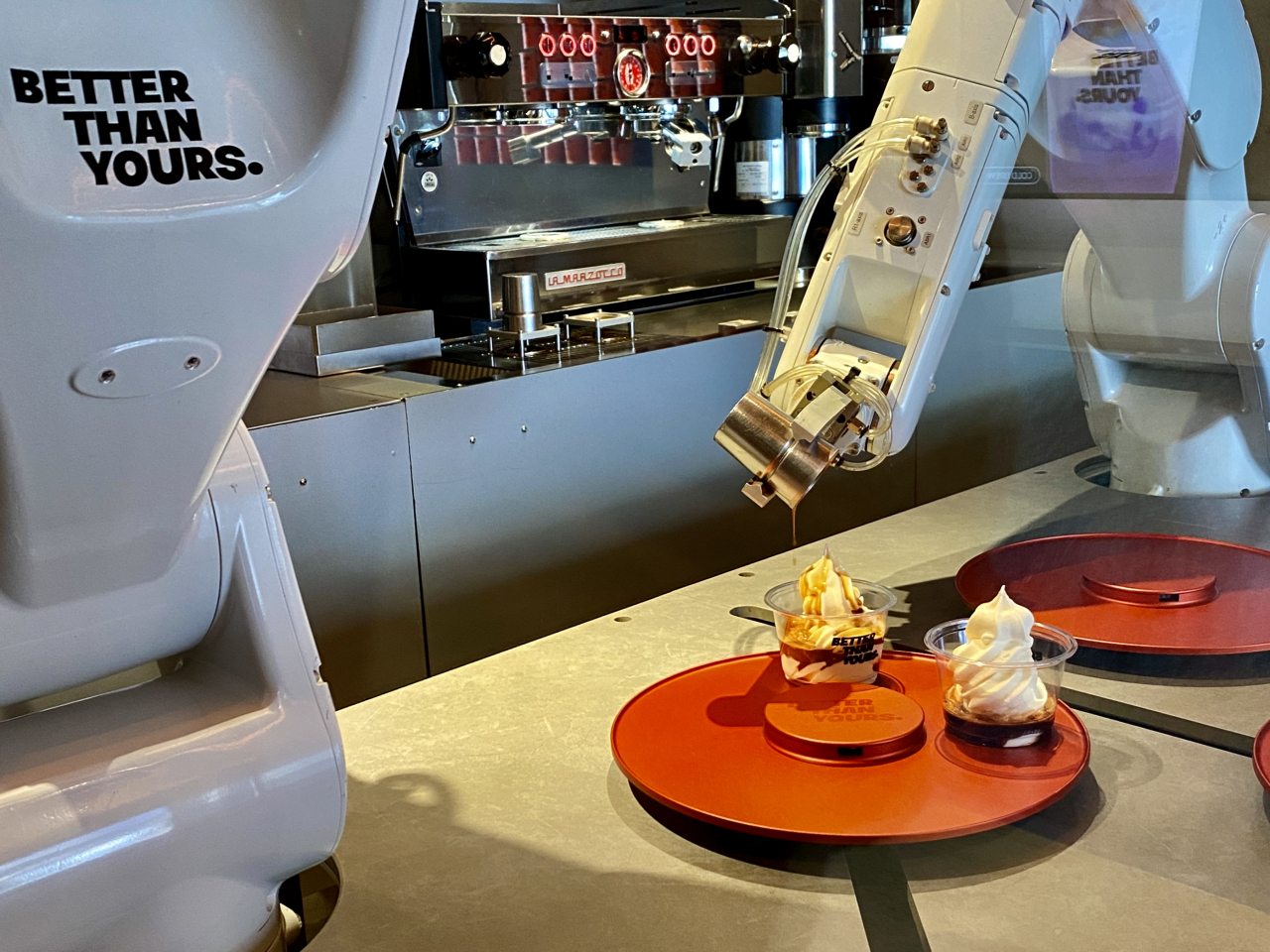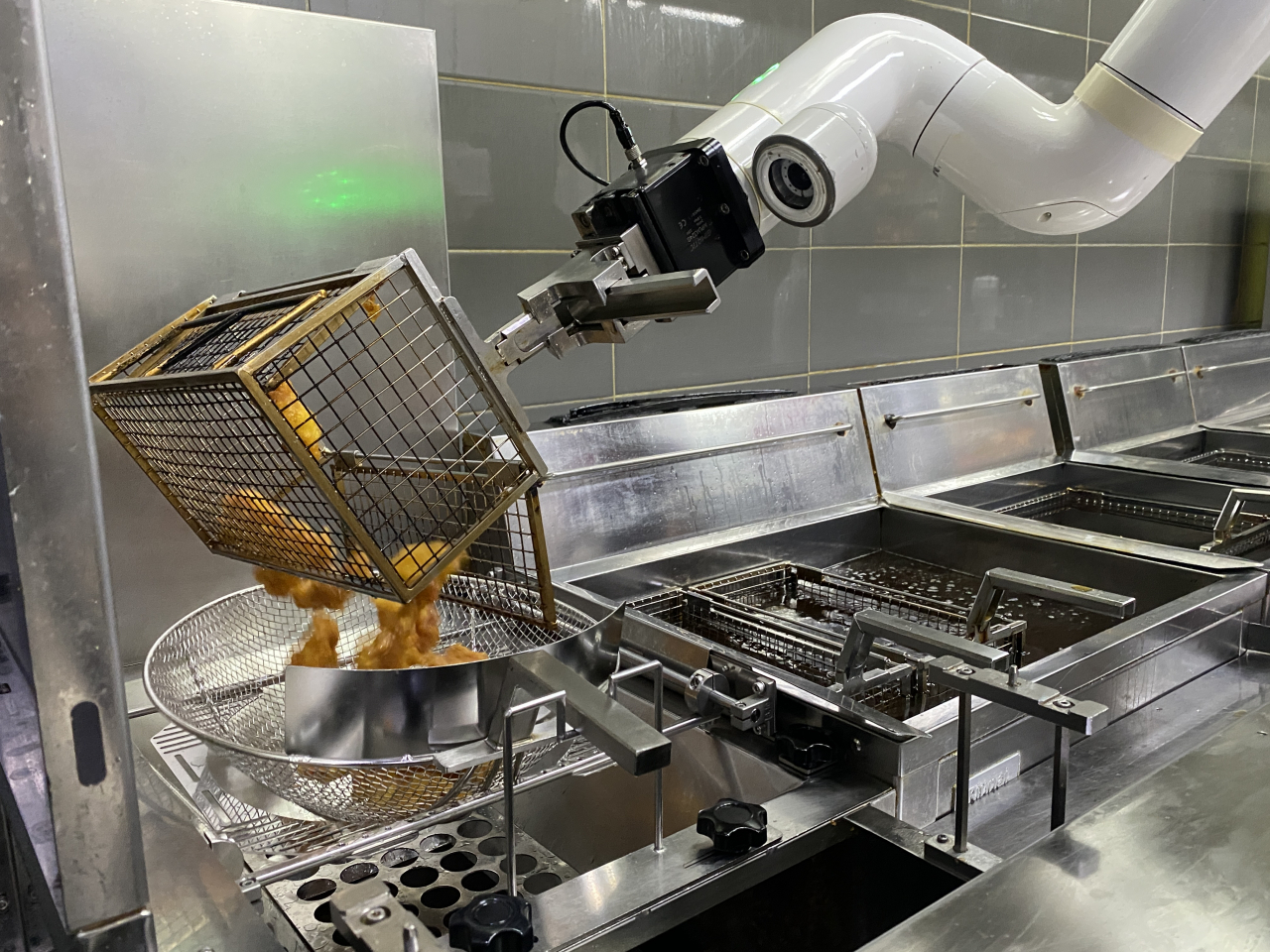
 |
| Barista robot Porty (right) pours an espresso shot over ice cream to make an affogato at Better Than Yours in Seongsu-dong, eastern Seoul, Wednesday. (Hwang Joo-young/The Korea Herald) |
Upon receiving an affogato order, the three-jointed arm of barista robot Porty readies the portafilter and locks it into the coffee grinder.
After extracting a fresh shot from the espresso machine, Porty pours it over a cup of ice cream, prepared by fellow robot, Mixie. When there are no visitors, the duo reportedly spend their time dancing to the cafe's background music.
Mixie and Porty are the only servers at Better Than Yours, a fully automated cafe in Seongsu, eastern Seoul. Together, they serve teas, coffee and ice cream based on visitors' orders specifying desired recipes, such as toppings, strength and additional shots. This setup allows Better Than Yours to operate 24/7 with just two hours of manual maintenance each day.
"Our robot baristas ensure consistency in every order while accommodating customers' preferred recipes and providing a unique experience," explains Robros, the local robotics startup that launched the cafe in 2023.
With pricing that calculates costs down to the last won based on exact ingredient amounts, Better Than Yours offers more affordable prices -- 2,463 won ($1.79) for an iced coffee -- compared to the average of 4,500 won at nearby cafes with human workers.
The use of robots in cafes like Better Than Yours reflects a broader shift in South Korea’s food industry, where robotics have become a tool for operations. Initially, serving robots were introduced as early as 2019, but companies are now expanding automation to include noodle-cooking and potato-peeling robots to address repetitive food preparation tasks.
Kyochon F&B, one of the country's leading fried chicken chains, now operates robot cooks in 12 outlets after expanding to seven more branches this year. The company has partnered with robotics firm Neuromeka to develop these fryers since 2021.
“I can’t say that the robots have increased the number of chickens fried per hour, but they have made our work so much easier. Before, we had to constantly monitor the fryers, but now we can focus on other tasks like applying sauces, cleaning or attending to customers," said Kim Jong-bok, 43, a Kyochon franchise restaurant owner in Namyangju, Gyeonggi Province.
 |
| A robot arm transfers fried chicken to a mesh strainer at a Kyochon branch in Namyangju, Gyeonggi Province, Wednesday. (Hwang Joo-young/The Korea Herald) |
Kyochon’s robot cooks are controlled through a Wi-Fi-connected tablet, allowing operators to select cooking times based on specific recipes. The robots handle various tasks such as frying, shaking off excess oil and transferring the cooked chicken to trays. "Previously, there were times we’d forget about the chicken in the fryer, causing overcooking. I’d like to see these robots implemented in even more areas," Kim said.
Leasing expenses for the robots range between 900,000 won and 1.2 million won per month. Kyochon said it plans to expand their use not only to more locations domestically to ensure standardized quality across branches but also to its US branches next year.
Likewise, another major franchise fried chicken brand, BHC Chicken, has introduced automated frying robots with LG Electronics since 2022, aiming to equip 30 stores by year-end. Burger franchise Lotteria, under Lotte GRS, introduced its own automated fryers called Bogglebots for the first time this month at a Seoul branch. Vips, a family restaurant chain under CJ Foodville, has deployed noodle-cooking robots across most of its outlets since 2022.
Beyond franchise restaurants, rest stops and mass catering companies -- which often serve large numbers of customers -- have also embraced robotics in their operations.
Pulmuone introduced its Robot Wok at seven rest stop locations this year, where labor shortages are common due to their location outside urban centers, according to the food giant. Similarly, Samsung Welstory, a major catering service provider, launched its Wellybot service in March, featuring a cooking robot capable of preparing large quantities of stews and soups for high-volume meal services.
Industry insiders expect robotics adoption in the food industry to keep expanding as people avoid repetitive jobs and some businesses attempt to increase their profit margins.
“With (certain) kitchen roles like assistants -- often labeled '3D' jobs -- becoming less attractive, robotics are emerging as a viable alternative,” said an industry official who requested anonymity. “As the labor market tightens and costs rise, companies are increasingly turning to automated solutions to streamline operations. With advancing technology, these innovations could potentially reshape the industry in the coming years.”
Recognizing the potential of robotics in food tech, the government also announced plans in September to foster 30 major robotics-focused startups by 2027, with a goal of achieving $2 billion in exports in this sector. The country's food tech market, which encompasses a broad spectrum of innovations -- including robotics, alternative food products, convenient meal technologies and digital solutions -- reached approximately 61 trillion won in 2020, according to government data.









